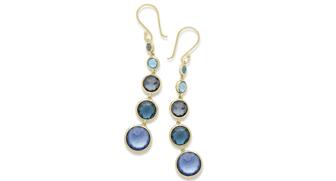The luxury goods company said founder Ippolita Rostagno will remain at the brand’s helm.
Squirrel Spotting: Why I Don’t Worry About Brick-and-Mortar Retail
Peter Smith says the idea that people will want to continue to do everything online post-pandemic is “complete and utter rubbish.”

There is a maxim that says, if customers don’t want to come nothing will stop them.
As maxims go, it’s about as topical as any in a retail environment that has seen foot traffic, or footfall, as my friends across the pond like to say, continue to decline.
That years-long trend, exacerbated by the disruption of COVID-19, might give one pause in projecting sunny days for brick-and-mortar retail.
Lord & Taylor, the first department store in the United States, went out of business just a few years shy of its 200th anniversary.
Pier 1, which started in 1962 as Cost Plus, took their 900 stores into bankruptcy in May, just three months or so after attempting to survive by announcing that they would close half of their stores.
Sur La Table, Brooks Brothers and Modell’s Sporting Goods also went Chapter 11, and Neiman Marcus has gone in and out of bankruptcy since the arrival of COVID-19.
So, what exactly is going on? What are we to make of the evolving retail landscape, particularly as it relates to brick-and-mortar stores?
Amid the flood of retail bankruptcies and the ongoing saga of stores like J.C. Penney, Sears, J. Crew, Express, etc., one thing is patently clear: Retail is overbuilt in the U.S., with more than 1,100 shopping malls and more than 23.5 square feet of shopping per person.
For context, Canada has 16.8, Australia has 11.2 and the United Kingdom has 4.6 square feet of shopping per person.
In “The Convenience Revolution,” Shep Hyken wrote: “Friction is a hassle in your customer’s world. Anything that removes friction, regardless of the source, is likely to improve your relationship with the customer.”
It would be difficult to make the case that visiting any of those 1,100 malls provides a frictionless experience.
We are seeing many of the Class C and D malls go away, or repurposed to the point they are unrecognizable.
That retail catharsis will likely continue for years to come.
If you have stores in those malls, even a great store, you’re going to find out what having the best house on the worst street is all about.
The transformation of those low-experience malls is neither a negative in and of itself, nor a de-facto reflection on the overall health of physical retail. It is an essential retail catharsis.
Additionally, we have the specter of online shopping and, understandably, the fear
But has it?
There is no doubt whatsoever that retail stores, no matter how small, must have an online presence to be relevant, particularly when you consider that 80 percent of consumers begin their shopping journeys online.
But lest we think the pandemic has delivered a mortal blow to physical stores, consider that during the apex of the shutdown, in April, May and June, when one might have expected the vast majority of retail shopping to have taken place online, the number was actually 15 percent, according to the U.S. Department of Commerce.
While statistically impressive, especially when compared to the 11 percent of online retail business in 2019, it is infinitely less than one might have expected given the weeks-long shutdown for many stores.
In “Consumer Neuroscience,” by Moran Cerf and Manuel Garcia-Garcia, it states: “The social pressure of the in-store environment means that people are less likely to pull out of a purchase once it has been started, whereas the absence of this in an online context means basket abandonment is a huge challenge for e-commerce.”
In fact, according to data from Listrak, a retail marketing firm that tracks shopping cart abandonment, the rate at which consumers abandon their shopping carts online without completing their purchases is 81 percent.
As critical as it is to be able to easily conduct e-commerce when that is what the customer wants, the combination of no human interaction, and no ability to experience the tactility that comes from in-store shopping, means quality brick-and-mortar environments will continue to have the lion’s share of the retail pie.
One of the great misconceptions of pandemic purgatory, as we’ve all learned to work remotely, have our groceries delivered, eat out less, and eschew the joys of attending live sporting events, concerts and movie theaters, is that we will be satisfied living in that kind of world post-pandemic.
That notion is complete and utter rubbish.
While commercial real estate is certain to take a hammering, as more and more companies realize that remote work can play a role post-pandemic, and restaurants will, no doubt, take more than their share of casualties, new businesses and new initiatives will fill those spaces.
Entrepreneurs will step in, and stores and restaurants will emerge from the ashes of those unfortunate businesses that ultimately succumbed to the pandemic with new and vibrant retail stories.
COVID-19, in effect, will not so much have killed healthy business but accelerated unhealthy and declining business.
What won’t change is our desire for human contact and the reassuring sense of community that comes from attending in-person events and shows, and from experiential shopping.
We will be less likely to frequent undifferentiated shopping malls—a trend accelerated during the pandemic, but long in the cards—but the dopamine rush that comes from meaningful experiences and in-person shopping will not abate.
Independent retailers have a huge advantage in the evolving retail story. They are not tethered to dying malls, corporate policy or outright indifference.
They can shift on a dime to deliver meaningful experiences to their customers by connecting on an emotional level and by engaging their customers’ senses with relevant and differentiated products in exciting retail spaces.
As Michael Dart and Robin Lewis wrote in “Retail’s Seismic Shift,” their 2017 book: “For retailers the next steps for success are clear. Pick your niche. If you are massive, get rid of the mass by fragmenting into niches. Create differentiation and awesome experiences for each niche.”
Seems like a reasonable plan to me.
The Latest

Laura Burdese, who joined the Italian luxury brand in 2022, will take on the role in July.

The National Jeweler editors revisit the most noteworthy industry happenings and design trends from 2025.

How Jewelers of America’s 20 Under 40 are leading to ensure a brighter future for the jewelry industry.

Need a gift for the cat lover who has everything? Look no further than our latest Piece of the Week.


It purchased the “Grosse Pièce,” an ultra-complicated Audemars Piguet pocket watch from the ‘20s, for a record-breaking price at Sotheby’s.

The lab-grown diamond grower now offers custom engagement and fashion jewelry through its Kira Custom Lab Jewelry service.

Roseco’s 704-page catalog showcases new lab-grown diamonds, findings, tools & more—available in print or interactive digital editions.

Chandler got his start at Michelson Jewelers and has served as DCA president and CEO since 2001. He will retire at the end of the month.

The boutique is slated to open this week inside Terminal 8, offering pre-owned Rolex watches and more to international travelers.

Sponsored by Digital Monitoring Products

The special-edition egg pendant ingested in a New Zealand jewelry store was recovered after a six-day wait.

Associate Editor Natalie Francisco plays favorites with Piece of the Week, selecting a standout piece of jewelry from each month of 2025.

The “Love and Desire” campaign is inspired by the magic that follows when one’s heart leads the way, said the brand.

Two awardees will receive free tuition for an educational course at the Swiss lab, with flights and lodging included.

Berta de Pablos-Barbier will replace Alexander Lacik at the start of January, two months earlier than expected.

Sotheby’s held its first two jewelry sales at the Breuer building last week, and they totaled nearly $44 million.

Winners will receive free registration and lodging for its fourth annual event in Detroit.

The honorees include a notable jewelry brand, an industry veteran, and an independent retailer.

Carlos Jose Hernandez and Joshua Zuazo were sentenced to life without the possibility of parole in the 2024 murder of Hussein “Sam” Murray.

Yood will serve alongside Eduard Stefanescu, the sustainability manager for C.Hafner, a precious metals refiner in Germany.

The New Orleans jeweler is also hosting pop-up jewelry boutiques in New York City and Dallas.

Set in a Tiffany & Co. necklace, it sold for $4.2 million, the highest price and price per carat paid for a Paraíba tourmaline at auction.

The jeweler’s “Deep Freeze” display showcases its iconic jewelry designs frozen in a vintage icebox.

Take luxury gifting to new heights this holiday season with the jeweler’s showstopping 12-carat sphene ring.

This year's theme is “Unveiling the Depths of the Ocean.”

In its annual report, Pinterest noted an increase in searches for brooches, heirloom jewelry, and ‘80s luxury.


























